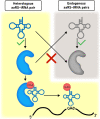iNClusive: a database collecting useful information on non-canonical amino acids and their incorporation into proteins for easier genetic code expansion implementation
- PMID: 37986218
- PMCID: PMC10767842
- DOI: 10.1093/nar/gkad1090
iNClusive: a database collecting useful information on non-canonical amino acids and their incorporation into proteins for easier genetic code expansion implementation
Abstract
The incorporation of non-canonical amino acids (ncAAs) into proteins is a powerful technique used in various research fields. Genetic code expansion (GCE) is the most common way to achieve this: a specific codon is selected to be decoded by a dedicated tRNA orthogonal to the endogenous ones. In the past 30 years, great progress has been made to obtain novel tRNA synthetases (aaRSs) accepting a variety of ncAAs with distinct physicochemical properties, to develop robust in vitro assays or approaches for codon reassignment. This sparked the use of the technique, leading to the accumulation of publications, from which gathering all relevant information can appear daunting. Here we present iNClusive (https://non-canonical-aas.biologie.uni-freiburg.de/), a manually curated, extensive repository using standardized nomenclature that provides organized information on ncAAs successfully incorporated into target proteins as verified by mass spectrometry. Since we focused on tRNA synthetase-based tRNA loading, we provide the sequence of the tRNA and aaRS used for the incorporation. Derived from more than 687 peer-reviewed publications, it currently contains 2432 entries about 466 ncAAs, 569 protein targets, 500 aaRSs and 144 tRNAs. We foresee iNClusive will encourage more researchers to experiment with ncAA incorporation thus contributing to the further development of this exciting technique.
© The Author(s) 2023. Published by Oxford University Press on behalf of Nucleic Acids Research.
Figures




Similar articles
-
Directed evolution of aminoacyl-tRNA synthetases through in vivo hypermutation.Nat Commun. 2025 May 24;16(1):4832. doi: 10.1038/s41467-025-60120-w. Nat Commun. 2025. PMID: 40413191 Free PMC article.
-
Performance analysis of orthogonal pairs designed for an expanded eukaryotic genetic code.PLoS One. 2012;7(4):e31992. doi: 10.1371/journal.pone.0031992. Epub 2012 Apr 6. PLoS One. 2012. PMID: 22493661 Free PMC article.
-
Genetic Code Expansion in Mammalian Cells Through Quadruplet Codon Decoding.Methods Mol Biol. 2023;2676:181-190. doi: 10.1007/978-1-0716-3251-2_13. Methods Mol Biol. 2023. PMID: 37277633
-
Practical Approaches to Genetic Code Expansion with Aminoacyl-tRNA Synthetase/tRNA Pairs.Chimia (Aarau). 2024 Feb 28;78(1-2):22-31. doi: 10.2533/chimia.2024.22. Chimia (Aarau). 2024. PMID: 38430060 Review.
-
Expanding the genetic code: In vivo approaches for incorporating non-proteinogenic monomers.J Microbiol. 2025 Mar;63(3):e2501005. doi: 10.71150/jm.2501005. Epub 2025 Mar 28. J Microbiol. 2025. PMID: 40195833 Review.
Cited by
-
Computationally Assisted Noncanonical Amino Acid Incorporation.ACS Cent Sci. 2024 Dec 16;11(1):84-90. doi: 10.1021/acscentsci.4c01544. eCollection 2025 Jan 22. ACS Cent Sci. 2024. PMID: 39866708 Free PMC article.
-
A Translation-Independent Directed Evolution Strategy to Engineer Aminoacyl-tRNA Synthetases.ACS Cent Sci. 2024 May 20;10(6):1211-1220. doi: 10.1021/acscentsci.3c01557. eCollection 2024 Jun 26. ACS Cent Sci. 2024. PMID: 38947215 Free PMC article.
-
Suppressor tRNAs at the interface of genetic code expansion and medicine.Front Genet. 2024 May 10;15:1420331. doi: 10.3389/fgene.2024.1420331. eCollection 2024. Front Genet. 2024. PMID: 38798701 Free PMC article. Review.
-
Noncanonical Amino Acids in Biocatalysis.Chem Rev. 2024 Jul 24;124(14):8740-8786. doi: 10.1021/acs.chemrev.4c00120. Epub 2024 Jul 3. Chem Rev. 2024. PMID: 38959423 Free PMC article. Review.
-
Fluorescent labeling strategies for molecular bioimaging.Biophys Rep (N Y). 2025 Mar 12;5(1):100200. doi: 10.1016/j.bpr.2025.100200. Epub 2025 Feb 12. Biophys Rep (N Y). 2025. PMID: 39947326 Free PMC article. Review.
References
-
- Hao B., Gong W., Ferguson T.K., James C.M., Krzycki J.A., Chan M.K.. A new UAG-encoded residue in the structure of a methanogen methyltransferase. Science. 2002; 296:1462–1466. - PubMed
-
- Böck A., Forchhammer K., Heider J., Leinfelder W., Sawers G., Veprek B., Zinoni F.. Selenocysteine: the 21st amino acid. Mol. Microbiol. 1991; 5:515–520. - PubMed
-
- Mody I. GABAA receptor synaptic functions. Encyclopedia of Neuroscience. 2009; Elsevier; 441–445.
-
- Gupta R., Gupta N., Bindal S.. Bacterial cell wall biosynthesis and inhibitors. Fundamentals of Bacterial Physiology and Metabolism. 2021; Singapore: Springer Singapore; 81–98.
-
- Morris S.M. Regulation of enzymes of urea and arginine synthesis. Annu. Rev. Nutr. 1992; 12:81–101. - PubMed
MeSH terms
Substances
Grants and funding
LinkOut - more resources
Full Text Sources
Other Literature Sources
Miscellaneous

